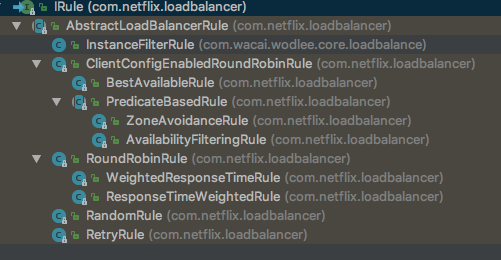你好,请教一下CustomHttpRequestInterceptor 怎么添加到 LoadBalancerInterceptor 之后
Open aCoder2013 opened 6 years ago
你好,请教一下CustomHttpRequestInterceptor 怎么添加到 LoadBalancerInterceptor 之后
@Tinkerc 因为要获取到实际的IP,因此必须保证你添加的拦截器的代码在ribbon初始化的地方之后执行。
有几种方式,比如你可以监听Spring初始化完成事件,然后注入RestTemplate,把自己自定义的拦截器添加进去。
@aCoder2013 嗯,我也是要获取实际IP,可以把关键源码贴出来一下吗,重新注入RestTemplate是否还需要单独设置@LoadBalanced
嗯,重新注入的是ribbon初始化完成之后的RestTemplate,只需要给RestTemplate再添加一个拦截器即可
@Resource
private RestTemplate restTemplate;
private AtomicBoolean started = new AtomicBoolean(false);
@Override
public void onApplicationEvent(ContextRefreshedEvent event) {
if (event != null) {
if (started.compareAndSet(false, true)) {
/*
Spring初始化完成后再执行
*/
List<ClientHttpRequestInterceptor> interceptors = restTemplate.getInterceptors();
if (interceptors == null) {
interceptors = new ArrayList<>();
}
interceptors.add(new LogClientHttpRequestInterceptor());
restTemplate.setInterceptors(interceptors);
}
}
}你好目前我也遇到了这个问题,在spring boot 1.5x集成ribbon和feign。思想是通过自定义规则实现某些特殊请求规则定义。但是和你记录的一样当请求返回时。rule的lb选择错误导致了404,自定义的规则不能去掉。请问第二种解法能详细说一说吗?
@lzn312 可以参考下官方的文档,用@ RibbonClients注解修饰你的配置类,这样会将这个配置类中的bean放在独立的spring上下文,而不是父context,https://cloud.spring.io/spring-cloud-netflix/multi/multi_spring-cloud-ribbon.html#_customizing_the_default_for_all_ribbon_clients
@aCoder2013 非常感谢你的回复,该问题已经通过配置@RibbonClients解决
博主您好,我是电子工业出版社博文视点的编辑,看到您发表的文章,觉得内容很好,您是否有兴趣出版图书呢:)
我的微信是472954195
你好,是要在@RibbonClients中再次配置IRule么
非常感谢,终于找到一个花了心思的靠谱解释
@AKwang100 很高兴能帮到你
你好,我的微信是Tnsg_ui_lip,想请教一下你这个问题,我也遇到这个情况,但是我们没有定义IRule,我暂时加了discoverClient#getInstances打印某个服务所有的uri
@aCoder2013 非常感谢你的回复,该问题已经通过配置@RibbonClients解决
麻烦问下如何解决的哇我用了@RibbonClients但是还是404
现象
前两天碰到一个ribbon相关的问题,觉得值得简单记录一下。表象是对外的接口返回内部异常,这个是封装的统一错误信息,Spring的异常处理器catch到未捕获异常统一返回的信息。因此到日志平台查看实际的异常:
这里介绍一下背景,出现问题的开放网关,做点事情说白了就是转发对应的请求给后端的服务。这里用到了ribbon去做服务负载均衡、eureka负责服务发现。 这里出现404,首先看了下请求的url以及对应的参数,都没有发现问题,对应的后端服务也没有收到请求。这就比较诡异了,开始怀疑是ribbon或者Eureka的缓存导致请求到了错误的ip或端口,但由于日志中打印的是Eureka的serviceId而不是实际的ip:port,因此先加了个日志:
这里是通过给RestTemplate添加拦截器的方式,但要注意,ribbon也是通过给RestTemplate添加拦截器实现的解析serviceId到实际的ip:port,因此需要注意下优先级添加到ribbon的
LoadBalancerInterceptor之后,我这里是通过Spring的初始化完成事件的回调中添加的,另外也添加了另一条日志,在catch到这个异常的时候,利用Eureka的DiscoveryClient#getInstances获取到当前的实例信息。 之后在测试环境中复现了这个问题,看了下日志,eurek中缓存的实例信息是对的,但是实际调用的确实另外一个服务的地址,从而导致了接口404。源码解析
从上述的信息中可以知道,问题出在ribbon中,具体的原因后面会说,这里先讲一下Spring Cloud Ribbon的初始化流程。
注意这个注解
@RibbonClients, 如果想要覆盖Spring Cloud提供的默认Ribbon配置就可以使用这个注解,最终的解析类是:atrrs包含defaultConfiguration,因此会注册RibbonClientSpecification类型的bean,注意名称以
default.开头,类型是RibbonAutoConfiguration,注意上面说的RibbonAutoConfiguration被@RibbonClients修饰。 然后再回到上面的源码:注意这里的SpringClientFactory, ribbon默认情况下,每个eureka的serviceId(服务),都会分配自己独立的Spring的上下文,即ApplicationContext, 然后这个上下文中包含了必要的一些bean,比如:
ILoadBalancer、ServerListFilter等。而Spring Cloud默认是使用RestTemplate封装了ribbon的调用,核心是通过一个拦截器:因此核心是通过这个拦截器实现的负载均衡:
然后将请求转发给LoadBalancerClient:
而这里的LoadBalancer是通过上文中提到的SpringClientFactory获取到的,这里会初始化一个新的Spring上下文,然后将Ribbon默认的配置类,比如说:
RibbonAutoConfiguration、RibbonEurekaAutoConfiguration等添加进去, 然后将当前spring的上下文设置为parent,再调用refresh方法进行初始化。最核心的就在这一段,也就是说对于每一个不同的serviceId来说,都拥有一个独立的spring上下文,并且在第一次调用这个服务的时候,会初始化ribbon相关的所有bean, 如果不存在 才回去父context中去找。
再回到上文中根据分流策略获取实际的ip:port的代码段:
也就是说最终会调用
IRule选择到一个节点,这里支持很多策略,比如随机、轮训、响应时间权重等:这里的LoadBalancer是在BaseLoadBalancer的构造器中设置的,上文说过,对于每一个serviceId服务来说,当第一次调用的时候会初始化对应的spring上下文,而这个上下文中包含了所有ribbon相关的bean,其中就包括ILoadBalancer、IRule。
原因
通过跟踪堆栈,发现不同的serviceId,IRule是同一个, 而上文说过,每个serviceId都拥有自己独立的上下文,包括独立的loadBalancer、IRule,而IRule是同一个,因此怀疑是这个bean是通过parent context获取到的,换句话说应用自己定义了一个这样的bean。查看代码果然如此。 这样就会导致一个问题,IRule是共享的,而其他bean是隔离开的,因此后面的serviceId初始化的时候,会修改这个IRule的LoadBalancer, 导致之前的服务获取到的实例信息是错误的,从而导致接口404。
解决方案
解决方法也很简单,最简单就将这个自定义的IRule的bean干掉,另外更标准的做法是使用RibbonClients注解,具体做法可以参考文档。
总结
核心原因其实还是对于Spring Cloud的理解不够深刻,用法有错误,导致出现了一些比较诡异的问题。对于自己使用的组件、框架、甚至于每一个注解,都要了解其原理,能够清楚的说出这个注解有什么效果,有什么影响,而不是只着眼于解决眼前的问题。